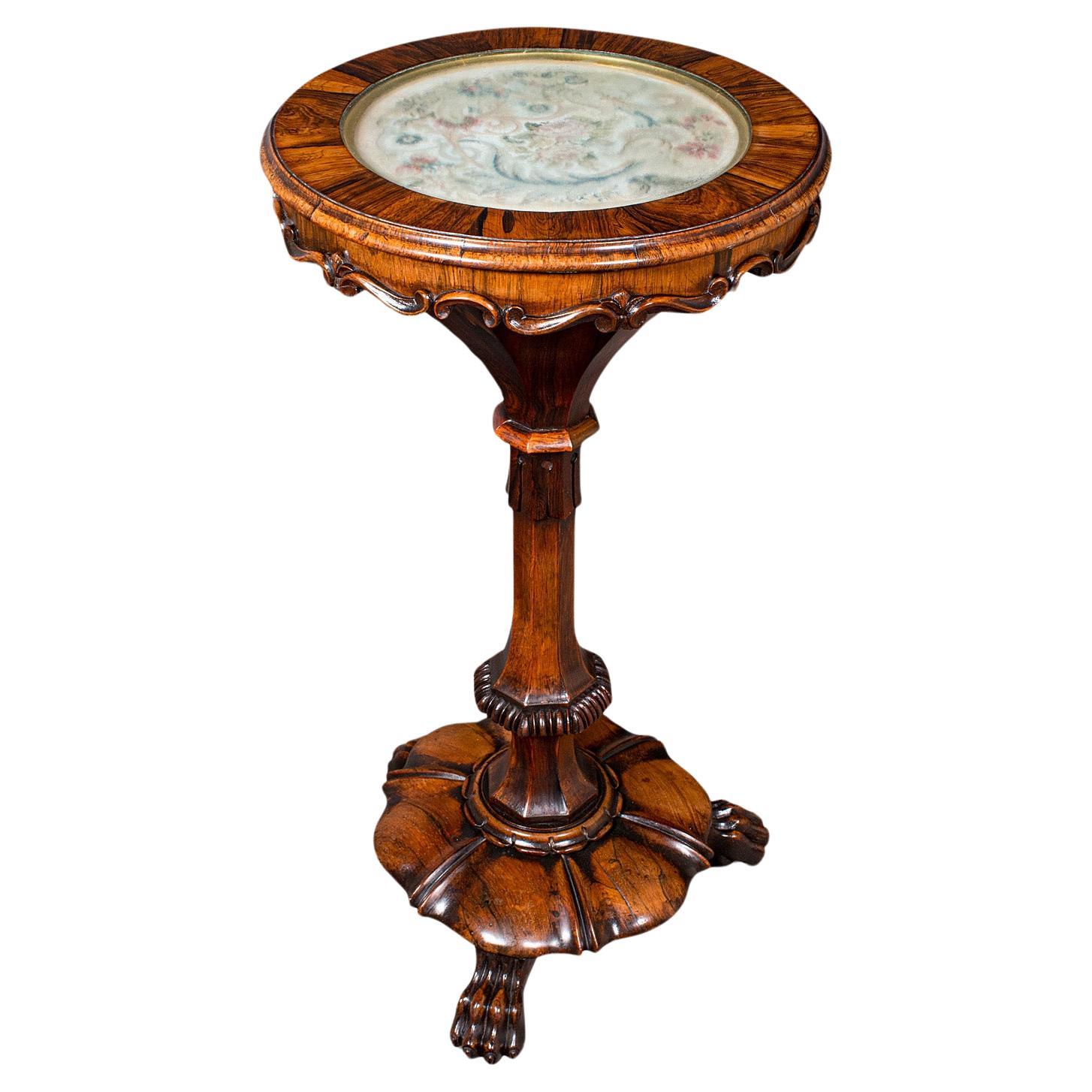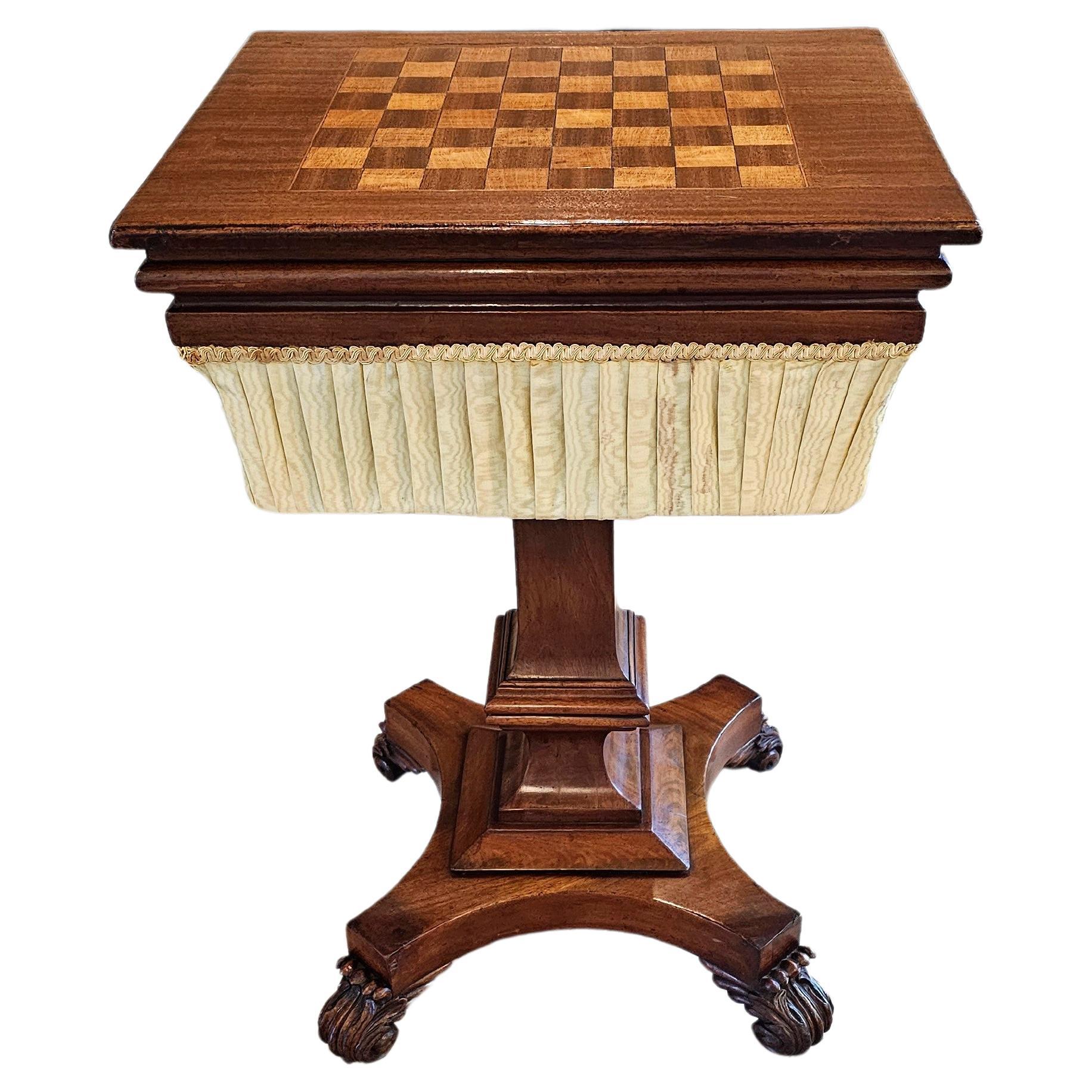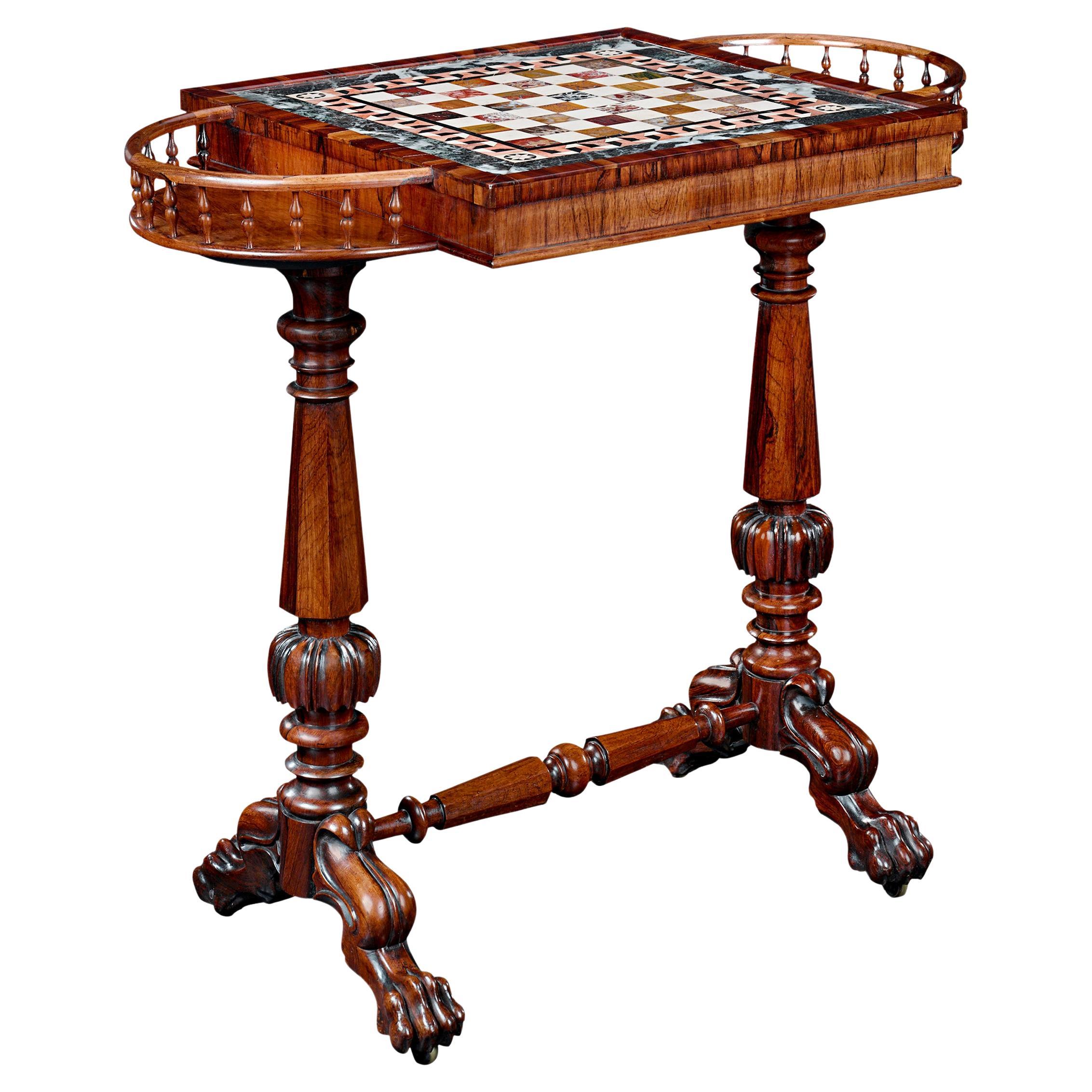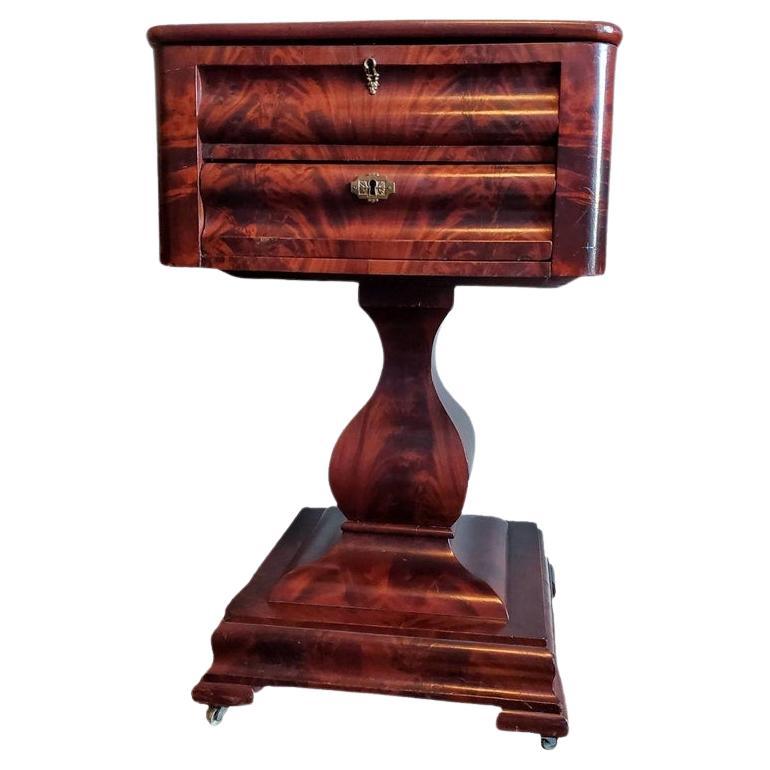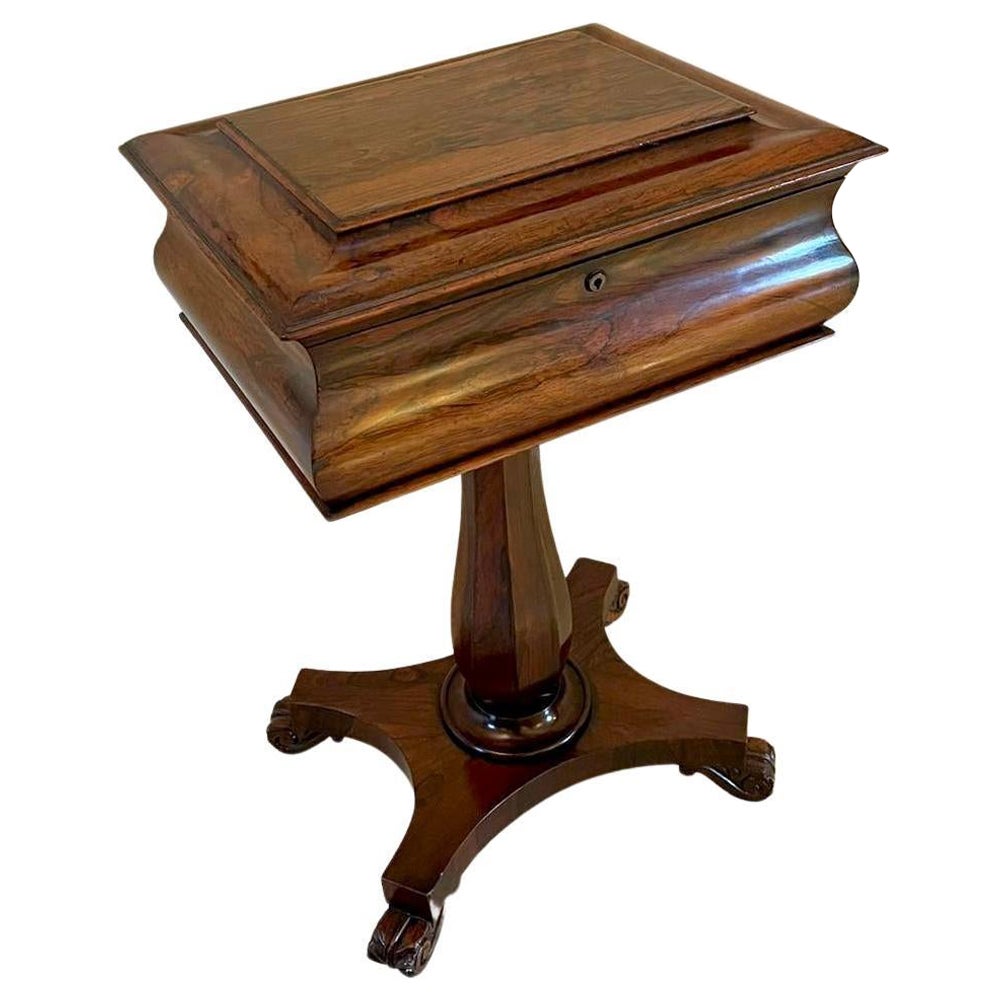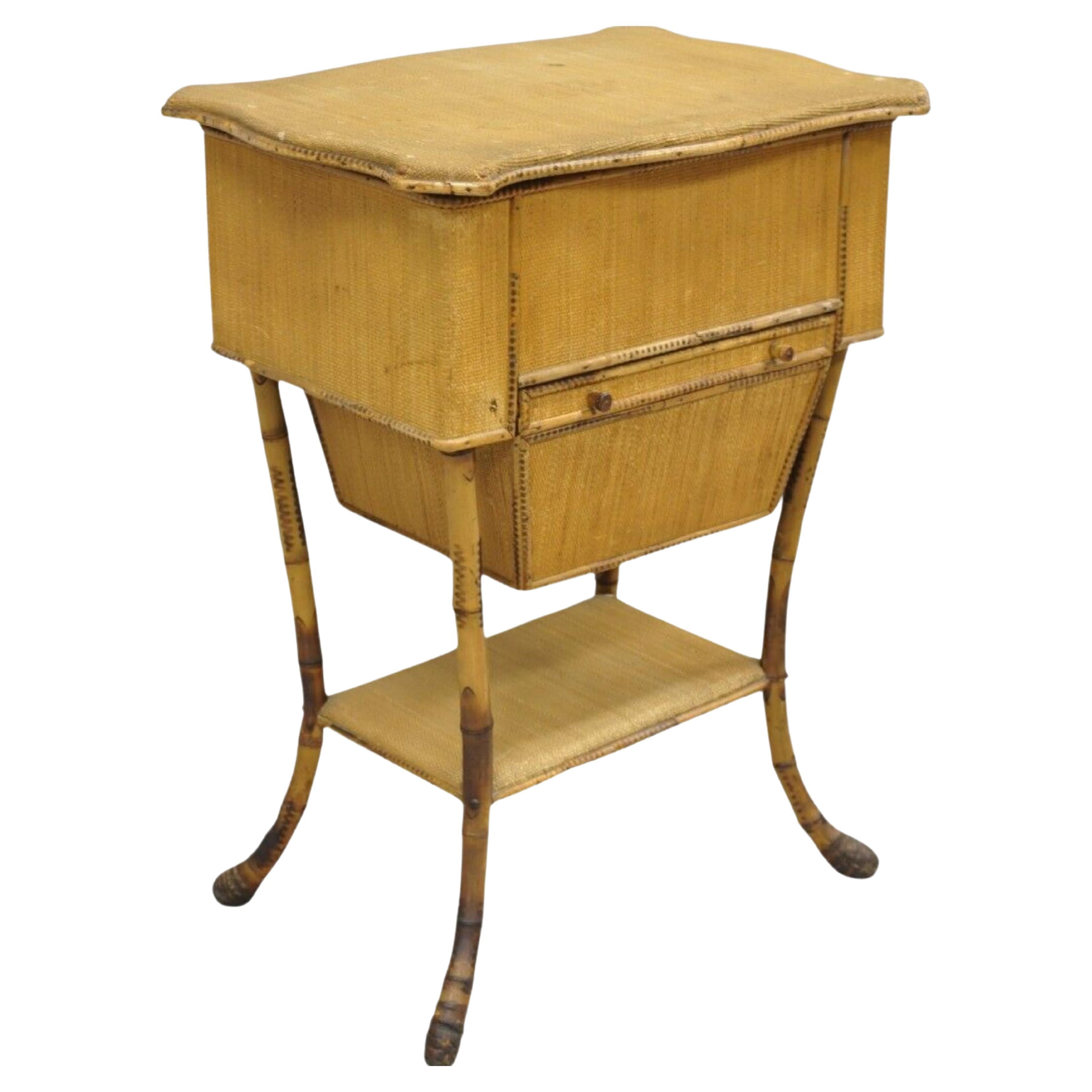Items Similar to William IV Period English Sewing Stand Work Table
Want more images or videos?
Request additional images or videos from the seller
1 of 21
William IV Period English Sewing Stand Work Table
About the Item
A scarce nearly 200 year old English William IV Period rosewood and mahogany sewing stand work table with beautifully aged warm rustic patina. circa 1830s
Combining sophisticated elegance, warmth, classic simplicity, and functional design, this outstanding example was born in England in the mid-19th century, exquisitely hand-crafted of warm rich exotic rosewood, having a rectangular top with richly figured grain detail, over single frieze drawer with divided interior and quality hand-cut dovetail joinery, sliding spacious bin with the original blue fabric upholstered basket, flanked by decorative drop finials, rising on turned stretcher-joined trestle base, terminating on scroll feet.
DIMENSIONS: (approx)
29.5" High, 21" Wide, 15" Deep
VERSATILE:
As warm and handsome as it is useful, having the ideal size and proportions for a variety of different uses, including as a chair side table, sofa end table, occasional table, bedside nightstand, cocktail drinks server, diminutive hall console / pier table, petite parlor lamp stand, historic decorative accent piece, and more!
WILLIAM IV FURNITURE HISTORY:
It was unexpected that, at the age of 64, William IV was crowned king of England. He had two older brothers, yet the death of Prince Frederick put him in line for the British throne when George IV died in 1830. His reign was brief, as he died on June 20, 1837, but it was a pivotal time of change, with parliamentary reform leading to the present-day constitutional monarchy. Antique William IV–style furniture reflects this period of transition, with forms that bridged the neoclassicism of the preceding Regency style and the more extravagant Victorian style that would follow.
Inspired by ancient Greece and Rome, William IV designs were often more imposing than Regency furniture and featured decorative attributes. There were sofas balanced on lion’s feet and tables with brass fittings. But furnishings of this period were largely marked by straight lines and subdued ornamentation compared to those of the George IV era. William IV had an unassuming way about him and was much more formal, whereas the ruler who preceded him was a king of extravagance. George IV had an affinity for French decor and was heavily invested in overhauling the private residences at Windsor Castle.
Carvings on William IV four-poster beds and cabinets included scrolling shapes, lotus leaves and acanthus, while popular pieces like tilt-top tables and upholstered seating on caster legs provided flexible interiors. Richly toned woods like mahogany and rosewood were used for sideboards, bedposts boasting reeded details and dining chairs with intricate chair backs and turned front legs.
William IV left no legitimate heirs, so his young niece, Victoria, became queen. She would lead an era of taste in which the innovations of the Industrial Revolution allowed for manufacturing showier furniture to fill elaborate interiors. With its comparatively refined forms and restrained designs, William IV style was a pause before a time of radical aesthetic change.
PROVENANCE / ACQUISITION:
A private Highland Park estate collection of fine museum quality period antiques
Acquired from highly reputable auction house, J. Garrett Auctioneers, Dallas, Texas.
CONDITION:
Great condition with beautifully aged patina over the whole. Strong, sturdy, stable, structurally sound. Retaining original antique character and charm throughout, including scattered nicks, light scratches to top, fading or discoloration to original fabric basket cover, past restorations, all wear consistent with age and indicative of use, nothing that detracts from the aesthetics or functionality but only adds to the overall authenticity, elegant rustic warmth and rich historical depth that can only be acquired over very long periods of time.
Delivered cleaned, waxed, with hand rubbed polished French patina finish, ready for immediate use and generational enjoyment!
- Dimensions:Height: 29.5 in (74.93 cm)Width: 21 in (53.34 cm)Depth: 15 in (38.1 cm)
- Style:William IV (Of the Period)
- Materials and Techniques:
- Place of Origin:
- Period:
- Date of Manufacture:circa 1830s
- Condition:Wear consistent with age and use. Great condition w/beautifully aged patina. Sturdy, stable, structurally sound. Retaining original antique character/charm throughout, including scattered nicks, light scratches, fading to fabric. Wear consistent w/age & use. Cleaned, waxed, polished.
- Seller Location:Forney, TX
- Reference Number:1stDibs: LU5977234976942
About the Seller
4.8
Platinum Seller
These expertly vetted sellers are 1stDibs' most experienced sellers and are rated highest by our customers.
Established in 2013
1stDibs seller since 2021
200 sales on 1stDibs
Typical response time: <1 hour
- ShippingRetrieving quote...Ships From: Forney, TX
- Return PolicyA return for this item may be initiated within 7 days of delivery.
More From This SellerView All
- 19th Century English William IV Period Mahogany Games Table Sewing StandLocated in Forney, TXA period William IV English mahogany sewing stand work table with inlaid chessboard top. circa 1830s Combining sophisticated elegance, warmth, and functional design, this outstandin...Category
Antique Mid-19th Century English William IV Game Tables
MaterialsIron
- Early American Classical Empire Period Flame Mahogany Sewing Stand Work TableLocated in Forney, TXA rare fine quality Federal period American Empire flame mahogany sewing stand work table from the early 19th century. Exquisitely hand-crafted in the northeastern United States, most likely Philadelphia, Pennsylvania, circa 1820, having a hinged top, opening to reveal contrasting Birdseye maple marquetry oval cartouche inlay, a fitted maple divided compartment interior, the front having two nicely shaped curved drawer fronts, consisting of a faux drawer front over a single dovetailed ogee drawer, above a vasiform pedestal standard, molded stepped platform base, rising on bracket feet, resting on casters. Attractive highly figured crotch cut swirl mahogany with striking grain patterns, rich and deep antique wood color...Category
Antique Early 19th Century American Empire Side Tables
MaterialsBirdseye Maple, Mahogany
- Early 19th Century English Regency Period Sewing TableLocated in Forney, TXAn elegant Regency period English mahogany and rosewood work table, circa 1815, in the manner of Gillows, having an attractive flame mahogany top with rope trim detail, above a singl...Category
Antique Early 19th Century Regency Side Tables
MaterialsMahogany, Rosewood, Fabric
- Louis Philippe Period French Walnut Sewing Stand Work TableLocated in Forney, TXA handsome nearly 200 year old French Louis Philippe period (1830-1848) walnut travailleuse (sewing work table - thread stand) Born in France in the mid-19th century, hand-crafted o...Category
Antique Mid-19th Century French Louis Philippe Industrial and Work Tables
MaterialsMirror, Walnut
- 19th Century French Carved Walnut Sewing Work Stand Quilt RackLocated in Forney, TXA rare and unusual antique circa 1870s French trestle-form sewing work stand / quilt rack with beautifully aged heavily worn patina. France, late 19th ce...Category
Antique Late 19th Century French Rococo Side Tables
MaterialsUpholstery, Walnut
- 19th C. French Charles X Restoration Period Sewing Stand Work TableLocated in Forney, TXA scarce period Charles X (1818-1834) French Restoration mahogany travailleuse sewing (thread stand - side table - jewelry dressing table) with light, warm, beautifully aged patina. Born in France in the early 19th century, almost certainly Parisian work, exquisitely hand-crafted, this exceptionally executed example features ornate gilt bronze ormolu mounts, escutcheons, and elaborate gilt metal trim. Having a highly figured light mahogany hinged lid top, lifting open to reveal a striking finished interior with divided compartments and original inset mirror plate. The conforming rectangular case fitted with a faux drawer front over a dovetailed drawer with sectioned interior. Elegantly rising on oval-shaped medial shelf stretcher-joined curvacious legs. Dimensions (approx): 27" High, 20" Wide, 13.5" Deep Stunning light almost blonde antique mahogany coloring and mellow warm tone, superb wood grain detail, and charming, beautifully aged patina over the whole. Great shape overall. Retaining original antique character marks, wear consistent with age and indicative of minimal use, nothing that detracts from the aesthetics or functionality, but only adds to the overall authenticity, refined elegant warmth, luxurious sophistication, and cozy unpretentious rustic elegance. Delivered cleaned, hand waxed, polished French patina finish, ready for immediate use and generational enjoyment! What is Charles X style: The comte d’Artois – or Charles X - was the son of the dauphin Louis-Ferdinand de Franc and Marie-Josèphe de Saxe. He succeeded his two brothers Louis XVI and Louis XVIII and became the King of France in 1824. Thirty years after the French Revolution, he wanted to embody the return of monarchy and became the leader of the catholic party . As the previous kings, he was crowned in 1825 but he was soon overthrown by the revolution in July, 1830, called "Trois Glorieuses". He left then for England, Scotland, Prague and Istria where he died in 1836. Charles X style lasted from 1818 to 1834 and happened during the Bourbon Restoration (French Restoration). This style did not replace totally the style of furniture from the French Empire but it was different from the formalism in the Napoleonic era, during which strictness and simplicity were inspired by Greco-Roman art. Indeed, artistic fields flourished. In terms of furniture, this renewal was suggested by the softening of shapes. Even though the simple aspect from the French Empire was still visible, shapes became curvier with volutes and arabesques. Another distinction is the loss of the massive aspect of furniture and the decrease of dimensions in order to decorate smaller appartments. Handling ability and comfort were key-words in the making of furniture. Apartments had essential elements such as chests of drawers, big rounded tables in the dining room, desks or secretaries, armoires and even dressing tables, comfortable fainting couches in the living room, small tables, pedestal tables, as well as gondola chairs. The wavy aspect of the latters certainly represent Charles X style the best. One of the most emblematic features of this style is the use of bois clairs – light woods in warm blond tones - and indigenous woods that are varnished in order to highlight the grains. Bird's-eye maple, ash trees, plane trees, yew trees, beech trees, olive trees and cedar trees were most likely to be used. Indeed, at the beginning of the 19th century dark woods were hard to find. In 1806, the Napoleon’s Continental System was established in order to ruin the United Kingdom by preventing the country from any business with the rest of Europe. Therefore craftsmen had to find alternatives from mahogany which was the most commonly used material at this time. After 1815, the import of wood was even more difficult because of peace treaties and the European political situation, which contributed to the popularity of the bois clairs and indigenous woods. The furniture was often decorated with fine inlays made out of dark wood representing foliage, which contrasted with the veneer. Even though these patterns can look like bronze decorations from the Empire era, they were far more simple and did not represent any military or mythological attributes. On the tables, trays were sometimes made out of marble as in the French Empire, but it was often put aside and inlaid veneer, Verre Eglomisé – a type of glass with a mirror finish –, mirror or porcelain from Sèvres or Paris were more likely to be used. Decorative elements from the Monarchy were highly appreciated again as they suggested luxury. Indeed, marquetry work was particularly fashionable - Boulle marquetry thrived around 1820 as the works of the Levasseur family can show. In the same way, draperies and trimmings referred to the monarchist splendour. Fabrics were often white – the traditional colour of the Bourbons – or light coloured as oppposed to the typical green from the Napoleonic era. One of the most symbolic figures from this period of time might be Jean-Jacques Werner (1791-1849), a cabinetmaker who worked for prestigious clients such as the Duchesse de Berry who was Charles’s step-daughter. His works can be seen at the Musée des Arts Décoratifs and at the Grand Trianon in the Palace of Versailles. The duchess’s appartments situated at the pavillon de Marsan and at the Palais de Saint Cloud illustrate Charles X style the best with furniture made out of bois clairs and ornamented with dark wood patterns or fine gold decorations. Chales X style allows a transition between the sobriety of the Empire style and the abundant aspect of Louis-Philippe style. The gothic style started at this time through the "style à la cathédrale", inspired by religious architecture, which thrived from 1827 to 1830. Indeed, at the beginning of the 19th century, Romanticism put the spotlight on the Middle Ages. Cabinetmakers were not inspired by the medieval furniture but rather by architectural elements of churches and cathedrals. For instance the backs of chairs were decorated with arches shaped like rib and serration. In the same way, before Charles X abdicated, pieces of furniture were made out of dark woods – such as mahogany, which was used again in France – and were inlaid with light wood. Romanticism also influenced the layout of furniture in appartments to suggest movement through a mix of various styles, various shapes and various sizes, as opposed to the static aspect of Neoclassicism. The start of industrialisation and mechanisation also influenced this style as early technical developments led to the production of pieces of furniture in series. Credit: Marc Maison Bibliography: FANIEL Stéphane (Dir.), Le Dix-neuvième Siècle Français, Collection Connaissance des Arts, 1957, Hachette SASSONE, Adriana Boidi, Furniture from Rococo to Art Deco, 2000, Evergreen -- Extremely versatile: As warm and attractive as it is useful, this remarkable antique table having the ideal size and small proportions for a variety of different uses, including as a side table, accent or occasional table, tall sofa...Category
Antique Early 19th Century French Charles X End Tables
MaterialsBronze, Ormolu
You May Also Like
- Antique Sewing Table, English, Needlepoint Tapestry, Crafting Stand, William IVLocated in Hele, Devon, GBThis is an antique sewing table. An English, rosewood and needlepoint tapestry crafting stand, dating to the William IV period, circa 1835. Exceptional sewing table, with glamourous interior and beautiful appearance Displays a desirable aged patina and in very good order throughout Select stocks present superb grain interest and deep chestnut and caramel hues Textured paper interior presents a shock of scarlet red to great effect Glazed circular top gently secured upon an inset pin lock mechanism Delightful circular tapestry...Category
Antique Early 19th Century British Side Tables
MaterialsWood
- William Iv-Period Specimen Chess TableLocated in New Orleans, LAA luxurious array of rare marbles and hard stones are inset into the playing surface of this William IV-period chess table. The visually appealing arrangement incorporates specimens ...Category
Antique 19th Century English William IV Game Tables
MaterialsMarble, Carrara Marble, Griotte Marble, Siena Marble
- Quality Antique William IV Rosewood Work BoxLocated in Suffolk, GBQuality antique William IV rosewood work box having a quality rosewood lift up top opening to reveal a storage compartment, shaped frieze and raised on a shaped pedestal column standing on a platform base with quality carved rosewood scrolled...Category
Antique 19th Century English William IV Side Tables
MaterialsRosewood
- Antique English Victorian Bamboo Rattan Sewing Box Work Stand Side TableLocated in Philadelphia, PAAntique English Victorian Bamboo Rattan Sewing Box Work Stand Side Table with Drawer. Item features a single drawer, lower shelf, flip top with interior storage and lift out tray (mo...Category
Antique 19th Century Victorian Side Tables
MaterialsBamboo, Wood
- 19th Century Mahogany Sewing Stand/Work TableLocated in Nantucket, MA19th century Mahogany sewing stand or work table. Upper three-sided gallery top with finger cutouts on sides above storage compartment with accordion style sliding door, with single...Category
Antique Late 19th Century Side Tables
MaterialsBrass
- William IV Work Table in Rosewood Sewing TableLocated in Whaley Bridge, GBSn2781, stunning William IV, rosewood sewing table, having lift up top enclosing fitted interior, tapering box below all with carved apron, standing on vase shaped pedestal with peta...Category
Antique 19th Century Industrial and Work Tables
MaterialsRosewood
Recently Viewed
View AllMore Ways To Browse
Four Poster Antique Style Bed
Antique King Poster Bed
Antique Poster Bed King
Antique Four Poster King Bed
Antique Four Poster King Size Bed
Victorian Sewing Stand
Antique English Bed Warmer
Antique Mahogany Sewing Cabinet
Antique Brass Bridge Lamp
William IV Mahogany Work Tables
William IV Mahogany Sofas
Rosewood Day Bed
Rosewood Single Bed
Single English Hall Chair
Regency Four Poster Bed
Sliding Day Bed
Regency Era Mahogany Dining
Victorian Four Poster Bed
